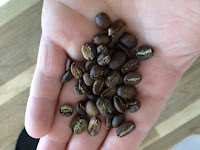| Paradoxurus |
As I graduated my education, my colleagues gave me
some presents. One of them was 70 gr. of the coffee kopi luwak.
A little background knowledge for those who don’t know the coffee in this link.
I
thought of this, as a perfect opportunity to make a review of my experiences.
This is a very hyped and discussed coffee, cashing in at about 600$ per kilo. With that in mind, my expectations was high.
This is a very hyped and discussed coffee, cashing in at about 600$ per kilo. With that in mind, my expectations was high.
beans are packaged in an air tight plastic bag. In my perspective, this is not a sign of quality.
 |
| I would like a one-way valve. |

The person who bought the coffee was told that they were roasted less than a week ago. I have a really hard time believing that. There were no aromas as I opened the bag, none what so ever.
I
decided to make a shot of espresso first. Dialing in the grinder with only 70 gr. of beans can be quite a challenge. I went for a brewratio of 55%. I managed
to make a decent shot in my first attempt. 20 gr. of dry coffee, giving me 37
gr. of extracted coffee in 28 seconds.
The aromas were still rather weak. When
I sipped the cup, a very powerful fresh, and fruity flavor fills my mouth. At
first I thought it was going to be a taste of acid. But the flavor staid, just
at the positive side. In my perspective of course. As the notes of fruit came
further back in my mouth, it became a penetrating nutty flavor, with hints of
caramel. After finishing the cup, the notes staid in my mouth for a long time.
I made a total of three shots espresso. All with the same outcome. Good, but no
way near a value of the price.
I
gave the last beans a go in my french press.
 |
| Just enough for one cup |

This way of brewing suits the
coffee much better. The earthy and nutty notes at the beginning, followed by
caramel notes at the end. Everything working together in a way ,that seems more
natural than in the espresso machine.
At our household, 70 gr. of beans
produces little more than 1 liters of coffee. I think it’s quite expensive, 55-60$ per liter
coffee. The price just don’t match the quality and experience.
I think this is a good coffee. It tastes good, works well and is easy to handle. I have defiantly tried better and much cheaper. Because of that, I wouldn’t buy it myself.
After
reading an article about the coffee, I might have found the answer to my lack
of enthusiasm. Andrew Hetzel from Coffee
Business Strategies,
reports of comprehensive fraud with this particular coffee. Big brands, big
money and big hype equal a lot of scammers. Unfortunately. It’s estimated that
5000% of the kopi luwak sold worldwide is fake. That’s a massive number. I am
tempted to think I am the proud owner of 100 gr. fake kopi luwak coffe.
Expensive coffee looks just like the cheap stuff, that is why no one knows if
their being scammed buying kopi luwak.
The organic perspective, with nature and animal in harmonic symbiosis seems to be deseving as well. If you are to trust Andrew Hetzel, the civet-like animal Paradoxurus are being held in small cages at large areas, while force-feed with coffee beans. Not the coffee fairytale the sellers tell and show its consumers. I haven’t looked further in to this accusation and don’t know if there is any kind of evidence. I sure hope it’s not so.
The article in Danish
The organic perspective, with nature and animal in harmonic symbiosis seems to be deseving as well. If you are to trust Andrew Hetzel, the civet-like animal Paradoxurus are being held in small cages at large areas, while force-feed with coffee beans. Not the coffee fairytale the sellers tell and show its consumers. I haven’t looked further in to this accusation and don’t know if there is any kind of evidence. I sure hope it’s not so.
The article in Danish
Best regards and a Happy Newyear
Caspar
Questions or comments can be posted in the commentfield, or at Xiburst@gmail.com

.JPG)












































